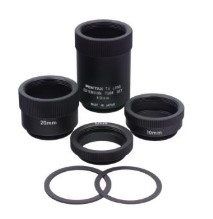Why Every Vision Engineer Needs an Extension Tube Set

Why an Extension Tube Set Belongs in Every Vision Engineer’s Toolkit
In industrial machine vision, the ability to detect the smallest details is often crucial. Whether inspecting fiducials on a printed circuit board, identifying microcracks in glass, or analyzing the surface texture of textiles, magnification plays a vital role. One of the simplest tools to achieve this is often overlooked: the extension tube set.
An extension tube is an optically neutral, cylindrical component mounted between the lens and the camera. It contains no glass or optical elements. By increasing the distance between the lens and the image sensor, the focus range of the lens changes. This allows you to focus more closely on an object, increasing the magnification. A standard lens thus takes on characteristics similar to those of a macro lens.
This makes extension tubes especially suitable for inspection tasks where features in the micrometer range need to be made visible. Examples include quality control of solder joints, analysis of plastic surfaces, or precise inspection of small mechanical components. A conventional lens configuration often isn’t sufficient for such tasks. With an extension tube, however, existing optics can still be used effectively.
One major advantage of an extension tube set is the ability to repurpose existing lenses for high-magnification applications. Instead of investing in expensive macro or telecentric optics, standard C-mount lenses can be used for a wider range of tasks. This is particularly useful during prototyping, in test setups, or in environments where flexibility is required. Most sets include multiple tubes that can be combined to achieve different levels of magnification.
There are, however, some limitations. The working distance becomes shorter as the extension tube length increases, which can be impractical in tight spaces. Additionally, the amount of light reaching the sensor is reduced, affecting exposure. This often requires additional lighting or longer exposure times. Depth of field also decreases, making stable mounting and precise alignment essential for reliable inspection results.
The magnification achieved with an extension tube can be calculated using the following formula:
Where is the magnification, is the total length of the extension tube in millimeters, and is the focal length of the lens. This formula assumes that the lens is focused at infinity. In that case, the original magnification of the lens is negligible. When using multiple extension tubes, their lengths can simply be added together.
For example, with a 35 mm lens and a 17.5 mm extension tube, the magnification is 0.5x. Adding another 17.5 mm tube results in a 1.0x magnification, meaning the object is imaged at actual size on the sensor. This is ideal for precise measurement and inspection tasks.
An extension tube set is therefore a simple, flexible, and cost-effective way to adapt standard vision hardware for applications requiring higher optical performance. It rightfully belongs in every vision engineer’s toolkit.




